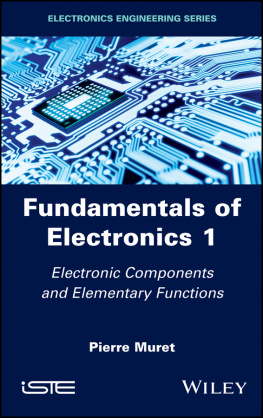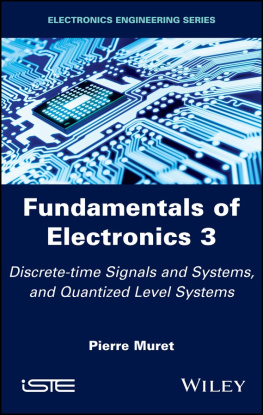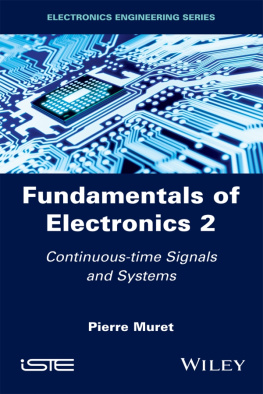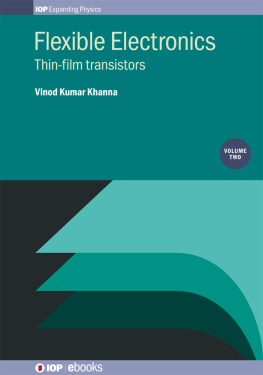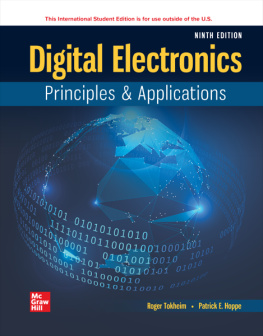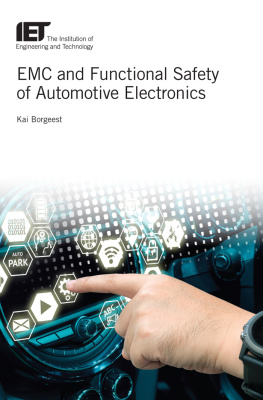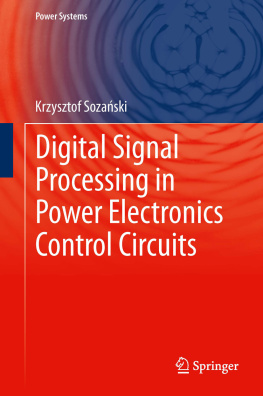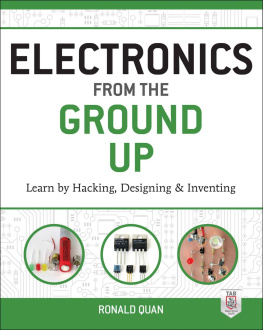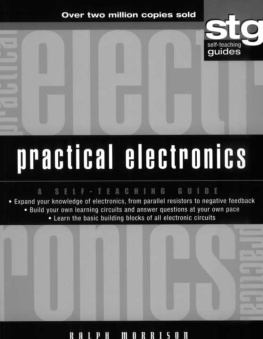
Fundamentals of Electronics 1
Electronic Components and Elementary Functions
Pierre Muret
First published 2017 in Great Britain and the United States by ISTE Ltd and John Wiley & Sons, Inc.
Apart from any fair dealing for the purposes of research or private study, or criticism or review, as permitted under the Copyright, Designs and Patents Act 1988, this publication may only be reproduced, stored or transmitted, in any form or by any means, with the prior permission in writing of the publishers, or in the case of reprographic reproduction in accordance with the terms and licenses issued by the CLA. Enquiries concerning reproduction outside these terms should be sent to the publishers at the undermentioned address:
ISTE Ltd
27-37 St Georges Road
London SW19 4EU
UK
www.iste.co.uk
John Wiley & Sons, Inc.
111 River Street
Hoboken, NJ 07030
USA
www.wiley.com
ISTE Ltd 2017
The rights of Pierre Muret to be identified as the author of this work have been asserted by him in accordance with the Copyright, Designs and Patents Act 1988.
Library of Congress Control Number: 2017944816
British Library Cataloguing-in-Publication Data
A CIP record for this book is available from the British Library
ISBN 978-1-78630-181-9
Preface
Today, we can consider electronics to be a subject derived from both the theoretical advances achieved during the 20th Century in areas comprising the modeling and conception of components, circuits, signals and systems, together with the tremendous development attained in integrated circuit technology. However, such development led to something of a knowledge diaspora that this work will attempt to contravene by collecting both the general principles at the center of all electronic systems and components, together with the synthesis and analysis methods required to describe and understand these components and subcomponents. The work is divided into three volumes. Each volume follows one guiding principle from which various concepts flow. Accordingly, Volume 1 addresses the physics of semiconductor components and the consequences thereof, that is, the relations between component properties and electrical models. Volume 2 addresses continuous time systems, initially adopting a general approach in . The chapter headings are indicated in the following general outline.
Each chapter is paired with exercises and detailed corrections, with two objectives. First, these exercises help illustrate the general principles addressed in the course, proposing new application layouts and showing how theory can be implemented to assess their properties. Second, the exercises act as extensions of the course, illustrating circuits that may have been described briefly, but whose properties have not been studied in detail. The first volume should be accessible to students with a scientific literacy corresponding to the first 2 years of university education, allowing them to acquire the level of understanding required for the third year of their electronics degree. The level of comprehension required for the following two volumes is that of students on a masters degree program or enrolled in engineering school.
In summary, electronics, as presented in this book, is an engineering science that concerns the modeling of components and systems from their physical properties to their established function, allowing for the transformation of electrical signals and information processing. Here, the various items are summarized along with their properties to help readers follow the broader direction of their organization and thereby avoid fragmentation and overlap. The representation of signals is treated in a balanced manner, which means that the spectral aspect is given its proper place, to do otherwise would have been outmoded and against the grain of modern electronics, since now a wide range of problems are initially addressed according to criteria concerning frequency response, bandwidth and signal spectrum modification. This should by no means overshadow the application of electrokinetic laws, which remains a necessary first step since electronics remains fundamentally concerned with electric circuits. Concepts related to radio-frequency circuits are not given special treatment here, but can be found in several chapters. Since the summary of logical circuits involves digital electronics and industrial computing, the part treated here is limited to logical functions that may be useful in binary numbers computing and elementary sequencing. The author hopes that this work contributes to a broad foundation for the analysis, modeling and synthesis of most active and passive circuits in electronics, giving readers a good start to begin the development and simulation of integrated circuits.
Outline
- 1) Volume 1: Electronic components and elementary functions.
- i) Diodes and applications
- ii) Bipolar transistors and applications
- iii) Field effect transistor and applications
- iv) Amplifiers, comparators and other analog circuits
- 2) Volume 2: Continuous-time signals and systems [MUR 17a].
- i) Continuous-time stationary systems: General properties, feedback, stability, oscillators
- ii) Continuous-time linear and stationary systems: Two-port networks, filtering and analog filter synthesis
- 3) Volume 3: Discrete-time signals and systems and conversion systems [MUR 17b].
- i) Discrete-time signals: Sampling, filtering and phase control, frequency control circuits
- ii) Quantized level systems: Digital-to-analog and analog-to-digital conversions
Pierre MURET
June 2017
Introduction
In this first volume, we address the physics of semiconductor devices directly through electrostatics and the laws steering the transport of charge carriers. This allows us to broach the governing principles at work in semiconductor electric components, which are described and quantified in order to expose the relations that control external electric quantities. Through the first three chapters, devoted, respectively, to diodes, bipolar transistors and field effect transistors, the electrical characteristics of these components can be deduced and expressed as electric models. We then consider the static or instantaneous voltages and currents present in these nonlinear or linear electric models to obtain the properties of active circuits made using these components and passive elements. In some cases, these considerations will require students to solve first-order differential equations or use complex impedance and transmittance to represent values in sinusoidal conditions (see ).
Each chapter emphases the applications derived from these models, in terms of analog and logical functions, a majority of which are based on the original nonlinearity of the components. Conversely, linearized models become useful mainly from . The content of the Appendix should be of use for the wider public who may be unfamiliar with the laws and theorems of electrokinetics, which are indispensable in this volume covering a variety of electronic circuits and equivalent component circuits. Exercises allow a deeper analysis of fundamental layouts comprising a small number of active devices, typically from two to 10.
Diodes and Applications
1.1. Semiconductor physics and current transport in pn diodes
Next page
